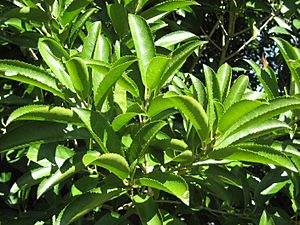Melicytus ramiflorus facts for kids
Quick facts for kids Melicytus ramiflorus |
|
|---|---|
 |
|
| Scientific classification | |
| Genus: |
Melicytus
|
| Species: |
ramiflorus
|
The Melicytus ramiflorus tree is often called māhoe or whiteywood. It's a special tree that grows only in New Zealand. You can find it almost everywhere in the forests there, especially in areas where new trees are growing.
What the Mahoe Tree Looks Like
The mahoe tree can grow quite tall, up to 10 metres high, which is like a three-story building! Its trunk can be as wide as 60 centimetres. It has smooth, light-coloured bark and twigs that break easily.
The leaves are dark green and grow in an "alternate" pattern, meaning they don't grow directly opposite each other on the stem. They are usually 5–15 centimetres long and 3–5 centimetres wide. The edges of the leaves have tiny saw-like teeth, but these are harder to see on younger plants.
Flowers and Berries
Mahoe trees are "dioecious" (say: dye-EE-shus). This means that each tree has either male flowers or female flowers, but not both. The small flowers are yellowish and about 3 to 4 millimetres wide. They grow in small bunches right out from the bare twigs. These tiny flowers have a strong, sweet smell!
The berries are very colourful when they are ripe. They are a bright violet and are mostly round, about 3 to 4 millimetres across. The flowers usually appear in late spring and early summer. The berries then show up later in summer and into autumn.
Who Uses the Mahoe?
Many native birds in New Zealand love to eat the mahoe berries. These include the kererū (New Zealand pigeon) and the tūī. Even some geckos, which are small lizards, have been seen eating these berries, even though they usually eat insects.
The mahoe tree is also important for a special moth called Austramathes purpurea. The caterpillars of this moth, which is only found in New Zealand, feed on the mahoe tree.
See also
 In Spanish: Mahoe para niños
In Spanish: Mahoe para niños

